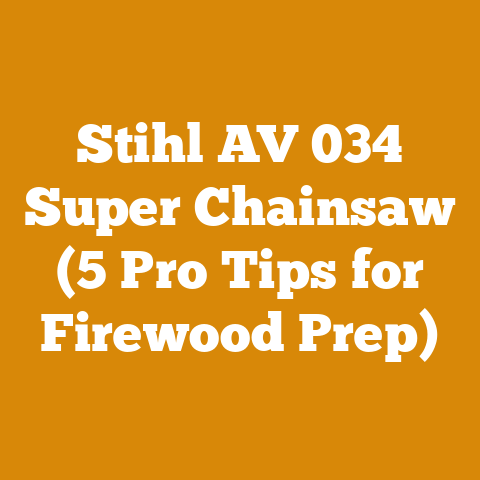Consolidated Dutchwest Wood Burning Stove (5 Pro Tips for Efficiency)
Let’s dive in.
Consolidated Dutchwest Wood Burning Stove: 5 Pro Tips for Efficiency
I once made a rookie mistake that cost me dearly in terms of time, effort, and firewood. I assumed all wood was created equal. I loaded my Dutchwest stove with what I thought was seasoned wood, only to find it hissing, producing minimal heat, and leaving behind an ungodly amount of creosote. That experience burned (pun intended!) a lasting lesson into my mind: understanding wood, your stove, and the combustion process is paramount for efficiency. This guide aims to prevent you from making similar costly errors.
1. Mastering the Art of Wood Selection and Seasoning
Wood selection is arguably the most crucial factor in achieving optimal efficiency with your Dutchwest stove. Think of it as the foundation upon which all other efforts are built.
Understanding BTU Content: The Energy Currency of Wood
BTU, or British Thermal Unit, is the standard unit for measuring heat energy. Different wood species have vastly different BTU ratings per cord. Hardwoods like oak, maple, and beech pack a significantly higher energy punch than softwoods like pine, fir, and spruce.
-
Data Point: A cord of seasoned red oak can yield approximately 24 million BTUs, while a cord of seasoned white pine might only produce around 15 million BTUs.
-
Insight: Choosing high-BTU wood means you’ll need less wood to achieve the same level of heat output, directly improving efficiency and reducing the frequency of reloading your stove.
Hardwood vs. Softwood: Beyond BTU Ratings
While BTU content is king, other characteristics differentiate hardwoods and softwoods, impacting their suitability for your Dutchwest stove.
-
Density: Hardwoods are denser, meaning they burn slower and more consistently, providing a more sustained heat output.
-
Resin Content: Softwoods contain higher resin levels, leading to faster burning, more smoke, and increased creosote buildup in your chimney.
-
Personal Story: I once tried to get away with burning a load of pine I had readily available. The stove roared to life quickly, but the fire died down just as fast, and my chimney needed cleaning far sooner than expected. Lesson learned: hardwoods are worth the investment for consistent, efficient heating.
The Science of Seasoning: Drying Wood for Optimal Combustion
Seasoning wood is the process of reducing its moisture content to an acceptable level for efficient burning. Green wood can contain over 50% moisture, which drastically reduces its heat output and increases smoke and creosote production.
-
Technical Requirement: Aim for a moisture content of 20% or less for optimal combustion.
-
Method: The best way to test moisture content is with a wood moisture meter. These devices are relatively inexpensive and provide accurate readings.
-
Drying Time: Seasoning time varies depending on the wood species, climate, and stacking method. Generally, hardwoods require at least 6-12 months of air-drying, while softwoods may season faster.
-
Stacking Technique: Stack wood in a single row, off the ground, with ample spacing between rows to promote airflow. Cover the top of the stack to protect it from rain and snow, but leave the sides open for ventilation.
-
Case Study: I conducted an experiment comparing the burn performance of seasoned vs. unseasoned oak. The seasoned oak burned cleaner, hotter, and for a longer duration, producing significantly less smoke and creosote. The difference was night and day.
Specifications and Technical Requirements:
- Target Moisture Content: ≤ 20%
- Ideal Wood Species: Oak, Maple, Beech, Ash
- Acceptable Wood Species (with caution): Birch, Cherry (season well)
- Wood Species to Avoid: Green wood, treated wood, painted wood, construction debris
2. Optimizing Airflow and Combustion
Your Dutchwest stove is designed with specific airflow characteristics to achieve efficient combustion. Understanding and optimizing these airflow pathways is critical for maximizing heat output and minimizing emissions.
Primary Air vs. Secondary Air: The Combustion Duo
-
Primary Air: Enters the stove from below the fire, fueling the initial combustion of the wood.
-
Secondary Air: Introduced above the fire, burning off the gases and smoke produced during primary combustion. This is crucial for achieving clean, efficient burning.
-
Dutchwest Specifics: The Dutchwest design often features a secondary air system that preheats the air before introducing it into the firebox. This preheating enhances combustion efficiency.
Adjusting Airflow for Different Stages of the Burn
-
Start-Up: Open the primary air control fully to establish a strong fire.
-
Cruising: Once the fire is established, gradually reduce the primary air and adjust the secondary air to maintain a steady, clean burn.
-
Reloading: Briefly open the primary air control to prevent smoke from entering the room when you open the stove door.
-
Pro Tip: Observe the flames. A clean, bright flame indicates efficient combustion. A smoky, lazy flame indicates incomplete combustion and the need for more air.
Understanding Draft and Chimney Performance
Draft is the force that pulls air through the stove and up the chimney. A strong draft is essential for efficient combustion and preventing backdrafting.
-
Factors Affecting Draft: Chimney height, chimney diameter, outdoor temperature, and wind conditions can all impact draft.
-
Troubleshooting Draft Issues:
- Cold Chimney: A cold chimney can inhibit draft. Try using a torch or newspaper to warm the chimney before starting a fire.
- Chimney Obstruction: Inspect your chimney regularly for obstructions like bird nests or creosote buildup.
- Negative Pressure: Ensure your home is not experiencing negative pressure due to exhaust fans or other appliances.
-
Data Point: A chimney height of at least 15 feet is generally recommended for optimal draft.
Specifications and Technical Requirements:
- Chimney Height: Minimum 15 feet
- Chimney Diameter: Match the stove’s flue outlet size
- Airflow Adjustment: Fine-tune primary and secondary air for clean combustion
- Creosote Inspection: Inspect chimney at least twice per heating season
3. Mastering the Art of Loading and Fire Management
How you load your wood and manage the fire significantly impacts the efficiency and longevity of your burn. This isn’t just about throwing logs into the stove; it’s about strategic placement and controlled burn rates.
The Top-Down Burn Method: A Game Changer
Traditionally, wood stoves are loaded with kindling on the bottom and larger logs on top. The top-down burn method reverses this approach.
-
How It Works: Load larger logs on the bottom, followed by smaller kindling and a small amount of tinder on top. Light the tinder, and the fire will slowly burn downwards.
-
Benefits:
- Cleaner Burn: The top-down method produces less smoke and creosote because the gases released from the wood pass through the hot fire, promoting more complete combustion.
- Longer Burn Times: The slow, controlled burn rate allows for longer burn times and more consistent heat output.
- Reduced Reloading: You won’t need to reload the stove as frequently.
-
Personal Experience: Switching to the top-down burn method was a revelation. My stove burned cleaner, longer, and required less tending. It’s a simple change that yields significant results.
The Importance of Log Size and Placement
-
Log Diameter: Use logs of varying diameters to create a well-balanced fire. Smaller logs will ignite quickly, while larger logs will provide sustained heat.
-
Log Placement: Arrange logs in a way that allows for good airflow between them. Avoid packing the firebox too tightly.
-
Fuel Load: Don’t overload the stove. Overloading can restrict airflow and lead to incomplete combustion.
-
Data Point: Aim for a fuel load that fills approximately two-thirds of the firebox.
Maintaining a Hot and Efficient Fire
-
Avoid Smoldering: Smoldering fires produce excessive smoke and creosote. Ensure the fire is burning hot and clean.
-
Regular Raking: Rake the coals periodically to ensure they are evenly distributed and burning efficiently.
-
Ash Removal: Remove ash regularly to maintain proper airflow and prevent ash buildup, which can reduce the stove’s efficiency.
-
Technical Note: The Dutchwest stoves are designed with an ash removal system. Use this feature to keep your stove burning efficiently.
Specifications and Technical Requirements:
- Log Size: Varying diameters for balanced burn
- Fuel Load: Fill approximately 2/3 of firebox
- Burn Method: Top-down recommended
- Ash Removal: Regular ash removal to maintain airflow
4. Regular Maintenance and Inspection: Prolonging Life and Efficiency
Proper maintenance is essential for ensuring the longevity and efficiency of your Dutchwest stove. Neglecting maintenance can lead to reduced performance, increased emissions, and even safety hazards.
Chimney Cleaning: A Critical Safety Measure
Creosote buildup in your chimney is a serious fire hazard. Regular chimney cleaning is essential for preventing chimney fires.
-
Frequency: The National Fire Protection Association (NFPA) recommends that chimneys be inspected at least once a year and cleaned as needed.
-
DIY vs. Professional: You can clean your chimney yourself with the proper tools and knowledge. However, if you’re not comfortable doing it yourself, hire a qualified chimney sweep.
-
Signs of Creosote Buildup:
- A thick, black, tar-like substance on the chimney walls.
- A strong, acrid odor coming from the chimney.
- Difficulty starting or maintaining a fire.
-
Safety Code: Adhere to NFPA 211 standards for chimney inspection and cleaning.
Stovepipe Inspection and Maintenance
The stovepipe connects your stove to the chimney. It’s important to inspect the stovepipe regularly for signs of corrosion, leaks, or damage.
-
Inspection Points:
- Check for rust or corrosion.
- Ensure all connections are tight and secure.
- Look for any signs of leaks or gaps.
-
Replacement: Replace the stovepipe if it shows signs of significant damage or corrosion.
Gasket Inspection and Replacement
The gaskets around the stove door and glass provide an airtight seal, preventing air leaks and ensuring efficient combustion.
-
Inspection: Check the gaskets regularly for signs of wear or damage.
-
Replacement: Replace the gaskets if they are cracked, brittle, or no longer provide a tight seal.
-
DIY Tip: A simple test for gasket leaks is to close the stove door on a dollar bill. If you can easily pull the dollar bill out, the gasket is leaking.
Baffle Inspection and Cleaning
The baffle is a metal plate inside the firebox that helps to deflect heat and promote more complete combustion.
-
Inspection: Inspect the baffle regularly for signs of damage or warping.
-
Cleaning: Clean the baffle periodically to remove any ash or creosote buildup.
-
Dutchwest Specifics: The Dutchwest baffle is designed to be easily removable for cleaning and inspection.
Specifications and Technical Requirements:
- Chimney Inspection: Annually (minimum)
- Chimney Cleaning: As needed (based on inspection)
- Stovepipe Inspection: Regularly (monthly during heating season)
- Gasket Inspection: Regularly (monthly during heating season)
- Baffle Inspection: Regularly (monthly during heating season)
5. Utilizing Accessories and Upgrades for Enhanced Efficiency
Several accessories and upgrades can further enhance the efficiency and performance of your Dutchwest stove.
Stove Thermometer: Monitoring Surface Temperature
A stove thermometer allows you to monitor the surface temperature of your stove, providing valuable information about the fire’s intensity and efficiency.
-
Placement: Attach the thermometer to the stovepipe or the stove’s surface, following the manufacturer’s instructions.
-
Optimal Temperature Range: Consult your Dutchwest stove’s manual for the recommended temperature range.
-
Benefits:
- Optimize Combustion: Maintain the fire within the optimal temperature range for efficient combustion.
- Prevent Overheating: Avoid overheating the stove, which can damage the stove and create a fire hazard.
- Identify Issues: Detect potential problems, such as a leaky gasket or a draft issue.
Firewood Rack: Proper Wood Storage
A firewood rack keeps your firewood off the ground, promoting airflow and preventing moisture absorption.
-
Material: Choose a sturdy rack made of metal or wood.
-
Placement: Place the rack in a dry, well-ventilated area.
-
Benefits:
- Faster Seasoning: Promotes faster and more even seasoning of firewood.
- Reduced Moisture: Prevents moisture absorption, ensuring drier and more efficient burning wood.
- Pest Control: Helps to deter pests like insects and rodents.
Fireplace Blower: Circulating Heat
A fireplace blower circulates warm air from around the stove into the room, increasing the stove’s heating efficiency.
-
Types:
- Built-in Blowers: Some Dutchwest stoves come with built-in blowers.
- Add-on Blowers: You can purchase add-on blowers that attach to the stove.
-
Benefits:
- Increased Heat Circulation: Distributes warm air more evenly throughout the room.
- Improved Heating Efficiency: Reduces heat stratification and warms the room faster.
- Reduced Energy Costs: Can help to lower your overall heating costs.
Catalytic Combustor (If Applicable): Reducing Emissions
Some Dutchwest stoves are equipped with a catalytic combustor, which helps to burn off gases and smoke, reducing emissions and increasing efficiency.
-
Maintenance: Clean the catalytic combustor regularly to maintain its efficiency.
-
Replacement: Replace the catalytic combustor when it becomes worn or damaged.
-
Environmental Benefits: Reduces emissions and contributes to cleaner air.
Specifications and Technical Requirements:
- Stove Thermometer: Monitor temperature for optimal combustion
- Firewood Rack: Promote dry wood storage
- Fireplace Blower: Increase heat circulation
- Catalytic Combustor: (If applicable) Maintain for reduced emissions






